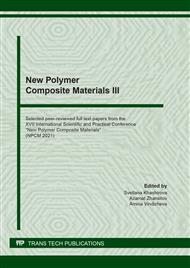p.644
p.660
p.675
p.681
p.688
p.694
p.701
p.709
p.715
Local Dissipative Processes in the Epoxy Component
Abstract:
It is known that epoxy resins (ES) and materials based on them are widely used in various areas of natural economy due to their valuable properties: low shrinkage during curing, high adhesion to various materials, chemical resistance, good physical and mechanical properties, and excellent dielectric properties [1].
Info:
Periodical:
Pages:
688-693
Citation:
Online since:
September 2021
Keywords:
Price:
Сopyright:
© 2021 Trans Tech Publications Ltd. All Rights Reserved
Share:
Citation:


